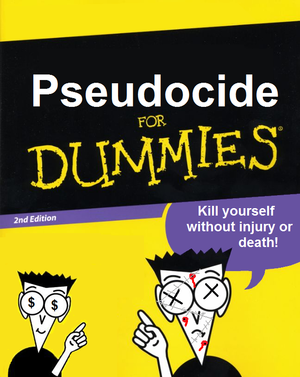Pseudocide
“I did this once.”
– Jack Bauer on Pseudocide
“Me too.”
– Horation Caine on Pseudocide
Pseudocide, also known as faking your own death, is when a person convinces other people that they are dead by leaving proof (of their death) and continuing life under a new identity. Committing pseudocide only works if people care that you were alive in the first place. It was originally believed that in order to fake one's own death, one had to be alive to do so, however in recent times there have been more and more documented case of Zombies, Vampires and other Undead successfully committing Pseudocide[1]
Pseudocide is a common practice in several countries (despite being illegal and criticized by authority figures) and participants are generally put into two categories: the people who see it as merely a recreational activity and those who interpret it as an art which one must be skillful at to ultimately master by avoiding jail-time, among other things.
History[edit | edit source]
Faking your death is no doubt a timeless tradition. Recently discovered cave paintings in Canada have revealed that even primitive cavemen took part in the act of pseudocide. However, pseudocide wasn't very popular back then and the situation certainly didn't get any better throughout the next few thousand years. Things began to look up with the arrival of playwright William Shakespeare.
Shakespeare himself was no stranger to pseudocide; he had already faked his own death twice before he began writing plays. Presumably inspired by self-experience, Shakespeare began to have characters in his plays fake their own deaths, most notably Juliet from Romeo and Juliet, who takes a temporary coma-inducing drug to avoid marrying a man named Paris. The Elizabethian public were thrilled with and inspired by this new idea, and began to try it out for themselves. "Pseudo fever" made its way to Spain with the help of Francis Drake and the English Armanda. In his spare time, Drake demonstrated the activity to his enemies (it's that addictive!). Meanwhile, American tribes were starting to practice pseudocides themselves. Details of this are sketchy but nevertheless point to one conclusion: faking your own death is a skill that man was born with and a skill that man will develop.
Motives[edit | edit source]

Methods[edit | edit source]
Here are some of the most common ways to fake your own death:
- Throw a mannequin in a lake
- Smear baby blood on the walls of your home
- Go to the New York Zoo and don't come back
- Pretend to become a Jersey Shore addict
- Hang your twin brother
- Blame it on a wizard
Books[edit | edit source]
Several books on pseudocide have also been released, however all authors of these books are dead.
The most notable of these are Pseudocide for Dummies (pictured), which sold 19 million copies the weekend it hit the shelves, and How to Disappear Completely and Never Be Found by Doug Richmond. The latter was also adapted into a play which won many awards.[2]
Conclusion[edit | edit source]
Pseudocide is fun. Give it a go!

